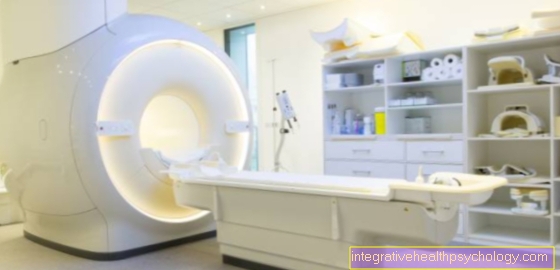Lymph granuloma inguinale
definition
Lymph granuloma inguinale is a manifestation of chlamydial infection. Chlamydia are bacteria of which different strains exist. The chlamydial germ that causes the sexually transmitted lymph granuloma inguinale is C. trachomatis of type L1-3. In the case of lymph granuloma inguinale, painless ulcers initially appear in the genital area. Once these have healed, a purulent swelling of the lymph nodes occurs.
causes
Lymph granuloma inguinale is caused by infection with a chlamydial strain called C. trachomatis. There are several subspecies of this germ. Types L1-3 cause lymph granuloma inguinale. Lymph granuloma inguinale is a sexually transmitted disease. the pathogen reaches the genital region of the person concerned through unprotected sexual intercourse.
diagnosis
There are several ways to diagnose chlamydial infection. The gold standard is the detection of chlamydial DNA from swabs of inflamed areas. There is also the possibility of cultivating the pathogen. However, this procedure is more complex and provides a result after 4 days at the earliest. Another possibility is the detection of antibodies in the blood of the person affected. However, these only become positive a few days after the infection and are therefore not suitable for acute diagnosis.
Read more about chlamydia diagnostics under Chlamydia test.
Symptoms
The disease can be divided into two stages. First, a painless ulcer develops at the point of entry of the pathogen. Since the infection is transmitted during sexual intercourse, it usually affects the penis or vagina. This skin appearance disappears after a few days. If the infection has not been treated by then, the secondary stage can occur. The pathogen spreads via the lymph vessels in the groin region and yet leads to inflammation. In the context of this lymph vessel and lymph node involvement, abscesses that are filled with pus can form. The genital, anal and groin regions can be affected. This stage is very painful and can be accompanied by other symptoms of infection such as fever and body aches.
Read here: I recognize a chlamydial infection by these symptoms.
treatment
The treatment of choice for chlamydial infection is antibiotic therapy. The antibiotic doxycycline is preferred. If the chlamydial infection manifests itself in the context of lymph granuloma inguinale, this antibiotic is used for 21 days. Alternatively, antibiotics from the class of so-called macrolides can be used, such as azithromycin. Since chlamydia are bacteria that reside and multiply inside the body's cells, the selected antibiotic must be able to cover this spectrum.
Read more about the here Therapy of a chlamydial infection.
Duration and course
If lymph granuloma inguinale occurs as part of a chlamydial infection, the painless ulcer appears at the point of entry after about a week. If no therapy is initiated in this primary stage, after approx. 3 weeks the secondary stage occurs, in which the lymphatic system becomes involved. Since this stage can be very painful, a doctor is usually consulted and antibiotic therapy initiated. If this is not the case, the secondary stage can pass into a tertiary stage. If the lymph nodes and vessels are inflamed for weeks or months, the process becomes chronic and the inflammatory tissue is remodeled with scarring. A so-called fibrosis then occurs, in which the tissue hardens. As the lymph fluid can no longer properly drain, lymphedema can occur.
How contagious is that?
Chlamydia infection is contagious. The bacteria can be transmitted from person to person via body fluids. This can not only lead to a transfer in the genital area, but also, for example, to a transfer from the genital to the eye area. This happens on the hands through a smear infection. Therefore, basic hygiene should always be observed. The chlamydial strain, which leads to the lymph granuloma inguinale, is only transmitted sexually. Using a condom is therefore the safest way to prevent infection. It is also important that the sexual partners of someone affected by chlamydial infection are also tested and, if necessary, treated.





























